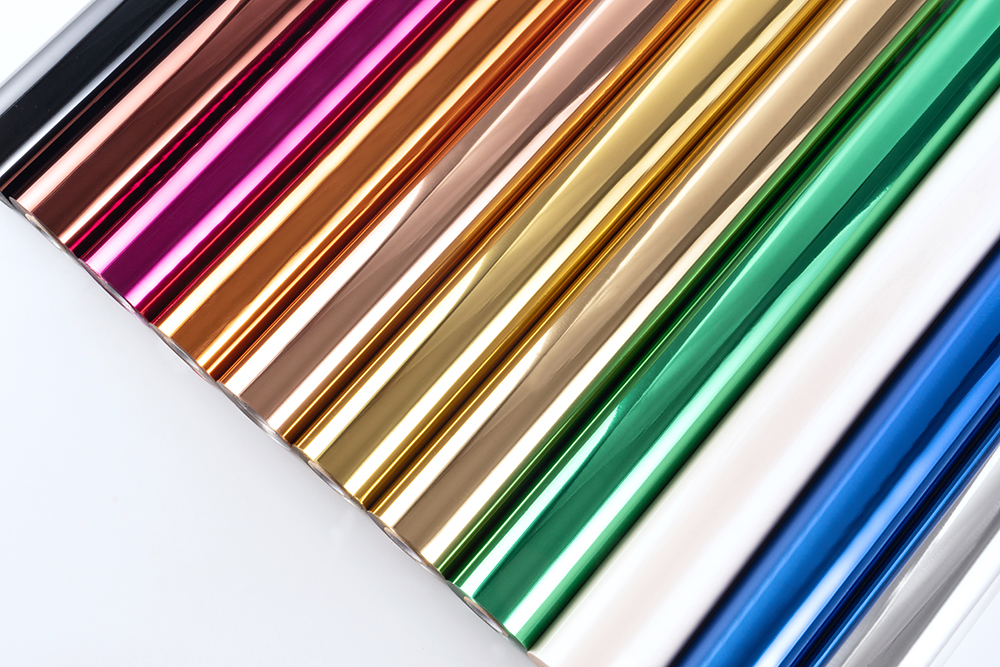The structure of hot stamping foil.
The structure of hot stamping foil can be divided into: base layer, peeling layer, color layer, electroplating layer, glue layer.
First: the basic layer
Generally, a biaxially stretched polyester film with a thickness of 12μm-25μm is used. The main function is to support the coatings attached to it, which is conducive to continuous hot stamping during processing. It has the properties of tensile resistance and instantaneous high temperature resistance.
Second: peel off the layer
Generally, it is coated with silicone resin. The main function is to make the color material, aluminum and glue layer can quickly separate from the polyester film after hot stamping and be transferred and bonded to the surface of the hot stamped object. The release layer has a good shedding performance, otherwise it will make the hot-stamping graphics and text blurred, blooming, and affect the quality of the hot-stamping product.
Third: Color layer
The main components are film-forming properties, heat resistance, transparency, suitable synthetic resins and dyes. Commonly used resins include polyurethane nitrocellulose, melamine formaldehyde resin, and modified rosin resin. During production, the resin and dye are dissolved in organic solvents to form a color paste, and then coated and dried. There are two main functions: one is to display the color; the other is to protect the image and text of the aluminized layer stamped on the surface of the article from oxidation.

The colors of anodized aluminum foil are golden, orange, gray, red, blue, and green. The color of the color layer is given luster after passing through the aluminized layer, and the color has a certain change, such as yellow after diamond plating and silver after gray plating. The coating requirements for the color layer are fine and without any small particles, so as to avoid trachoma and uniform coating.
Fourth layer: electroplating layer
The colored film is placed in the vacuum chamber of the vacuum continuous aluminum plating machine, and the aluminum wire is melted and continuously evaporated to the color layer of the film through resistance heating under a certain vacuum degree to form the aluminum plating layer. The main function of the aluminized layer is to reflect light and change the color of the color layer to make it appear metallic.
Fifth layer: glue layer
Generally fusible thermoplastic resin, according to different materials to be hot stamped, different resins can be selected, the resin is dissolved in an organic solvent or formulated into an aqueous solution, coated on the aluminum layer by a coating machine, and dried to form a glue The main function of the layer is to bond the hot stamping material to the hot object. When hot stamping, one of the main reasons for hot stamping is that the glue layer is not matched, and the type of anodized aluminum foil selected for different hot stamping objects should also be different.
First: the basic layer
Generally, a biaxially stretched polyester film with a thickness of 12μm-25μm is used. The main function is to support the coatings attached to it, which is conducive to continuous hot stamping during processing. It has the properties of tensile resistance and instantaneous high temperature resistance.
Second: peel off the layer
Generally, it is coated with silicone resin. The main function is to make the color material, aluminum and glue layer can quickly separate from the polyester film after hot stamping and be transferred and bonded to the surface of the hot stamped object. The release layer has a good shedding performance, otherwise it will make the hot-stamping graphics and text blurred, blooming, and affect the quality of the hot-stamping product.
Third: Color layer
The main components are film-forming properties, heat resistance, transparency, suitable synthetic resins and dyes. Commonly used resins include polyurethane nitrocellulose, melamine formaldehyde resin, and modified rosin resin. During production, the resin and dye are dissolved in organic solvents to form a color paste, and then coated and dried. There are two main functions: one is to display the color; the other is to protect the image and text of the aluminized layer stamped on the surface of the article from oxidation.

The colors of anodized aluminum foil are golden, orange, gray, red, blue, and green. The color of the color layer is given luster after passing through the aluminized layer, and the color has a certain change, such as yellow after diamond plating and silver after gray plating. The coating requirements for the color layer are fine and without any small particles, so as to avoid trachoma and uniform coating.
Fourth layer: electroplating layer
The colored film is placed in the vacuum chamber of the vacuum continuous aluminum plating machine, and the aluminum wire is melted and continuously evaporated to the color layer of the film through resistance heating under a certain vacuum degree to form the aluminum plating layer. The main function of the aluminized layer is to reflect light and change the color of the color layer to make it appear metallic.
Fifth layer: glue layer
Generally fusible thermoplastic resin, according to different materials to be hot stamped, different resins can be selected, the resin is dissolved in an organic solvent or formulated into an aqueous solution, coated on the aluminum layer by a coating machine, and dried to form a glue The main function of the layer is to bond the hot stamping material to the hot object. When hot stamping, one of the main reasons for hot stamping is that the glue layer is not matched, and the type of anodized aluminum foil selected for different hot stamping objects should also be different.
